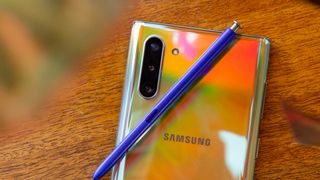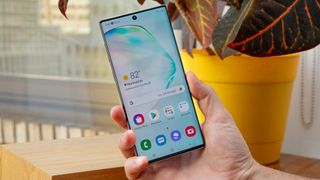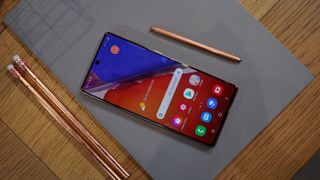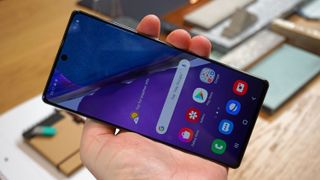Samsung Galaxy Note 20 vs Galaxy Note 10: we compare the stylus-toting smartphones
The S Pen is mightier than the sword

The Samsung Galaxy Note 20 has been announced, so we now know what Samsung's late-year powerhouse smartphone looks like.
This is a yearly upgrade on the Galaxy Note 10, with some new features and upgrades in a few different areas. It's also a chance for Samsung to improve on the Galaxy S20, S20 Plus and S20 Ultra from earlier in the year, which debuted lots of the tech we can see in this new phone.
While the Samsung Galaxy Note 20 was released alongside an even more powerful Note 20 Ultra (instead of a Plus model, like the Note 10 Plus), we're focusing on the standard model in this article, and comparing it to its predecessor, the Samsung Galaxy Note 10, so you can see how much of an upgrade the new model actually is.
Price and availability
The Samsung Galaxy Note 20 and Note 10 prices are fairly easy to compare, as both are only available in the same RAM and storage configuration - that is 8GB of RAM and 256GB of storage. At least, that's the case in the UK, though in the US you get just 128GB with the Note 20.
The Galaxy Note 10 costs $949 / £869 / AU$1,499 for that, while the Note 20 is $999 / £849 (around AU$1,550). It's worth pointing out that the phone in the US is 5G, while in the UK it's 4G-only - that may explain why the handset costs more than the Note 10 in the US yet less in the UK, though again, it also has less storage in the US.

Bear in mind that 5G contracts often cost more than 4G ones, so the price of operating the phone in the US will likely be higher than in the UK.
Generally speaking, then, the Note 20 and Note 10 occupy the same price point, so it's fine to compare them spec-for-spec. Though of course, being a lot older the Galaxy Note 10 is now often discounted.
Get daily insight, inspiration and deals in your inbox
Get the hottest deals available in your inbox plus news, reviews, opinion, analysis and more from the TechRadar team.
Design
The Samsung Galaxy Note 20 is quite a bit bigger than the Galaxy Note 10, and we'll get on to why in the 'Display' section. The newer phone is 10.1mm longer, 3.4mm wider and 0.4mm thicker, and it's also 24g heavier than the Note 10's 168g body, but since that's really lightweight for a flagship smartphone neither phone is overly heavy.
Both phones have glass screens and rears, with aluminum frames, so they'll feel similar in the hand.

The handsets also both have USB-C ports for charging and connecting to other devices, but no 3.5mm headphone jacks, so if you want to connect headphones you'll have to use an adapter or do so wirelessly.
You're getting an S Pen stylus with both phones, which can be used to mark up the screens, and they also have extra features that we'll get on to later.
In terms of colors, the Samsung Galaxy Note 20 is available in bronze, green and gray variants, while the Note 10 came in black, white, red, pink and 'Aura Glow', so it was arguably a more vibrant device, while the Note 20's colors are more subtle. The colors you can buy will likely depend on your country though.
Display
One of the biggest differences between the Samsung Galaxy Note 20 and Note 10 is just that - how big they are. The Note 10 has a 6.3-inch screen but the Note 20 is noticeably bigger at 6.7 inches across.
That's not the only screen difference - the Note 10's display curves at the edges, where the Note 20's is totally flat. Both have a punch-hole cut-out for the front-facing camera in the same spot, though, in the center-top of the screen.

The resolutions of the two screens are fairly similar, with the Galaxy Note 10 boasting a 2280 x 1080 resolution and the Note 20 beating that by a minor amount at 2400 x 1080. Since the Note 20 is much bigger, though, its pixel-per-inch count is lower at 393 compared to the Note 10's 401.
Both the Samsung Galaxy Note 20 and Note 10 have 60Hz refresh rates, which makes them different to the Galaxy S20 series and the Note 20 Ultra, both of which go up to 120Hz.
Camera and battery
The Samsung Galaxy Note 20 has a 12MP main, 12MP ultra-wide and 64MP telephoto camera, while the Note 10 has 12MP main, 16MP ultra-wide and 12MP telephoto snappers.
While on paper that might make the Note 20 sound look like a small upgrade (or even a downgrade in the case of its ultra-wide camera), the phone has newer sensors that can 'see' more light, so pictures should look better lit with more vibrant colors.
The newer phone gets to benefit from lots of the shooting modes introduced in the Galaxy S20 series, and not available in the Note 10. These include 'Single Take' which shoots a picture on multiple sensors to give you a variety of options, Live Focus Video for background blurring effects in video, and super-slow-mo shooting.
Talking of video, the Galaxy Note 10 can do that at 4K, but the Note 20 can reach 8K, so if you need super-high-res video the newer phone is for you.

The front-facing camera is 10MP on each phone, but as we've said sensor differences mean the newer handset will likely take better snaps.
The Samsung Galaxy Note 10 has a rather petite 3,500mAh battery, which is much smaller than the Galaxy Note 20's 4,300mAh, but in the grand scheme of things both are on the small side. Saying that, the Note 10 should last you about a day between charges, and we'd expect similar performance from the Note 20.
Both phones are totally equal in terms of wired charging speeds, at 25W, so if all you need is a device that charges quickly they'll both suit your needs.
The handsets also both have wireless charging as well as reverse wireless charging, so you can use the devices to power up other pieces of tech as long as they can charge wirelessly.
Specs and features
The Samsung Galaxy Note 20 packs the top-end Android chipset available at its time of launch, in the Snapdragon 865 Plus, which will return better processing speeds than the Note 10's Snapdragon 855. As previously stated, that's paired with 8GB of RAM in both devices.
Well, that's the chipset the phones will get in the US, but if you're in Europe you'll be picking up phones with Samsung's own Exynos chipsets, which are widely maligned for being behind the Snapdragon equivalents used. There, the Note 10 has the Exynos 9825, and the Note 20 has the Exynos 990, which is the same as the Galaxy S20 range in Europe.

Something worth noting is that neither the Galaxy Note 10 or Note 20 has the option for external storage cards, so you're stuck with 256GB in the Note 10 and either 128GB (if you're in the US) or 256GB (in the UK) for the Note 20.
Many people buy Samsung Galaxy Note phones to use the S Pen stylus, which they all have. This lets you doodle or sketch instead of using your finger for various tasks, and it has some other cool tricks too. For example, you can use the S Pen as a remote shutter for the camera app, so you can stand back and take a photo without having to actually touch the phone.
The Samsung Galaxy Note 10 launched running Android 9, whereas you get Android 10 out of the box on the Note 20. While you can easily upgrade to Android 10 on the Note 10, the Note 20 will likely keep getting new upgrades for a little while longer in the future. Both will probably be upgraded to Android 11 when that gets released though.
On both handsets, Android is overlaid with One UI, Samsung's custom user interface, which is largely a visual change.
As we've already said, while the Samsung Galaxy Note 10 was a 4G-only phone, the Note 20 comes in both 4G and 5G versions depending on what country you're in. If you're looking for a faster data connection or a more future-proof gadget, perhaps the 5G phone is better for you, though it's not going to be available to users in all countries.
Takeaway

The Samsung Galaxy Note 20 is something of a yearly iterative update on its predecessor - there are no huge changes, but you get upgrades and tweaks in a few areas.
The Note 20 has likely better cameras, a bigger battery, and a newer chipset - it's also much bigger. It doesn't have the curved-edge screen of its predecessor, nor does it quite match that phone's pixel-per-inch count on the display, but in general it's an upgrade.
While the phones launched at roughly similar price points, the Note 10 is now slightly more affordable thanks to a year of reductions and cuts, so it can still be a tempting purchase for people who don't need all the upgrades the Note 20 brings.
But given that the Samsung Galaxy Note 20 is 5G-compatible in some regions, its biggest competitor arguably isn't the Note 10, but other new 5G phones for similar or cheaper prices. So if you're after a 5G handset, perhaps look at our list of the best 5G phones instead.
- Check out all the best Samsung phones
- See the best Samsung Note 20 deals

Tom Bedford was deputy phones editor on TechRadar until late 2022, having worked his way up from staff writer. Though he specialized in phones and tablets, he also took on other tech like electric scooters, smartwatches, fitness, mobile gaming and more. He is based in London, UK and now works for the entertainment site What To Watch.
He graduated in American Literature and Creative Writing from the University of East Anglia. Prior to working on TechRadar, he freelanced in tech, gaming and entertainment, and also spent many years working as a mixologist. He also currently works in film as a screenwriter, director and producer.
Most Popular

